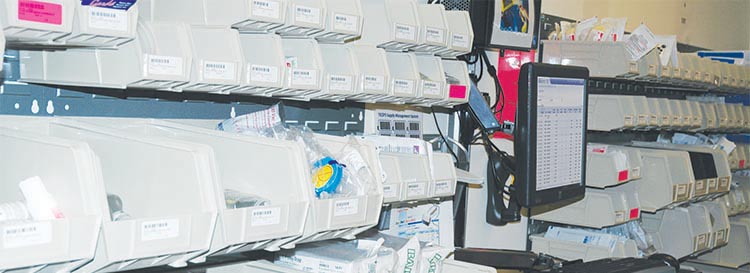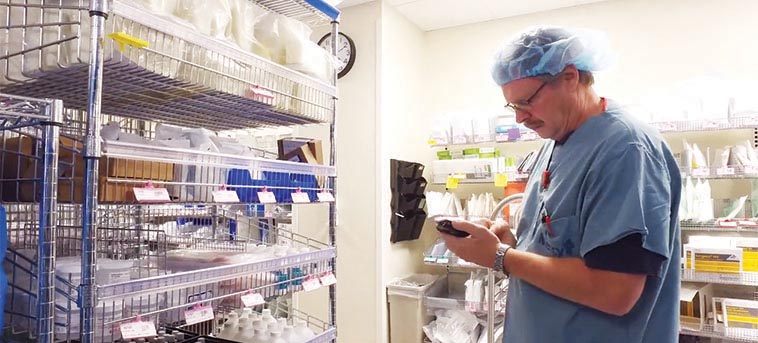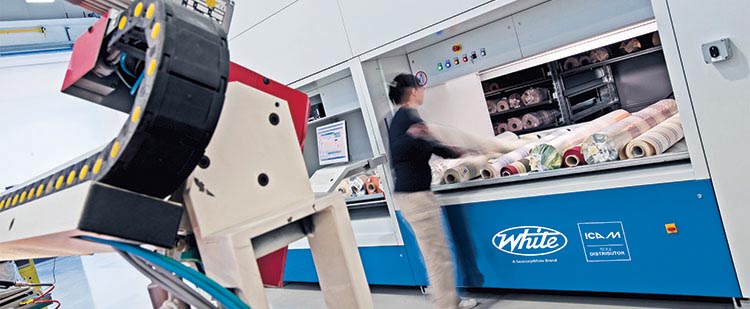Health care was one of the main tracks at Gartner’s Supply Chain Executive Conference in mid-May, and it included a presentation by the leader of Amazon’s global health care strategy. It’s no secret that Amazon is eyeing the health care space, whose high margins and overly cautious inventory practices present plenty of low-hanging supply chain fruit. Even if your business has nothing to do with health care, there’s a good chance you know what it feels like when Amazon enters your market.
The universal pressures of cost, speed, accuracy and traceability can threaten the survival of any e-commerce business. The health care industry is looking to centralization, direct-to-consumer strategies, tracking and goods-to-person-technologies to meet these challenges.
Roger Sharpe, director of health care strategy and sales for SCI Logistics, has experience in health care and e-commerce. Conveniently enough, he now finds himself in the middle of an ongoing merging of the two.
“Our focus has been on the sweet spot between health care and e-commerce, and it has exploded in the last 12 months,” Sharpe says. “The number of requests coming in is profound. From traditional consumer packaged goods companies to diabetes supplies or other specialty companies, they’re all looking to evolve with this wave of change.”
Patients and consumers share a hunger for convenience, Sharpe says. “Two-week snail mail doesn’t cut it, and the culture of immediacy will require changes in distribution centers as well as brick-and-mortar locations, no matter the market,” Sharpe says. “It’s about building better relationships with clients while at the same time upping the ante so you can compete with the big players in terms of service levels.”

Healthier operations
Enabled in part by the increased availability of off-the-shelf software and materials handling equipment, many hospital networks have begun centralizing their distribution operations to bypass third parties. Chris Lingamfelter, president of SencorpWhite’s White Systems, notes similarities to the early 1990s trend of retailer adoption of centralized distribution models.
“With a sophisticated DC, they can reduce stock in the hospital storerooms, manage that inventory better, and work more efficiently with suppliers,” Lingamfelter says. “Space and labor outside a hospital is much less expensive than inside, which further adds to the benefits of things like more efficient pick paths.”
The new health care supply chain model centers on direct-to-consumer capabilities, where it can benefit from lessons learned in the broader e-commerce shift from pallet and case quantities to high-throughput piece picking.
“Once they begin down the direct-to-consumer path, companies become incredibly interested in how they can exploit that channel further,” Sharpe says. “Suddenly you’re putting marketing materials in with shipments or creating customized kitting to stock or to order. Suddenly, the typical materials handling equipment in a facility is changing completely.”
Like consumer goods, health care suppliers are trying to reduce cycle times, and in many cases same-day shipments have become the norm, according to Jose Bejarano, senior consulting engineer for Bastian Solutions.
“Customers have pushed inventory to distributors or manufacturers a little bit, and now hospitals might not keep as many specialized devices and treatments in stock as they once would,” Bejarano says. “Saline and sutures are always in stock, but knee replacement implants are very tailored for the consumer, so you make them to order as opportunities arise. On the distribution side, there’s not a lot of foresight into orders, which might come later in the day as a doctor’s office closes. They need to go quickly, which is very similar to what you see in e-commerce. Health care companies are likely to also start playing the ‘catch up with Amazon’ game, or they’ll go on the defensive and make sure they’re better at what they do before Amazon gets there.”
A tamper-proof seal
John Reichert, senior director of SCE solutions for TECSYS, says investment in solutions to solve these distribution challenges depends on a company’s confidence that they understand what the future looks like. Pharmaceutical companies—or any of the increasing number of companies handling any supplement that requires licensing or temperature requirements—have to contend with the Drug Supply Chain Security Act (DSCSA). Passed in 2013, the act imposes incremental deadlines through 2023 for the capture and management of transaction details through the supply chain.
“Nobody wants to invest money in things that might not be ideal in a couple of years,” Reichert says. “This is another parallel with materials handling trends in general; they need the ability to quickly and cost-effectively adapt systems to change. Automation is becoming more flexible and relocatable, like autonomous mobile robots. Data collection requirements will change so automated software systems will also need to be able to adapt and integrate with new technologies.”
Parkview turns more than $17 million of annual expenses into revenue

Parkview Health is a not-for-profit, community-based health system that serves seven acute care hospitals across three states. Parkview recognized a need for significant change in the supply chain strategy and infrastructure of its integrated delivery network. The company embarked on a search initiative for a warehouse-centric solution with the objective: “To transform Parkview’s supply chain to deliver safe, high-quality, patient-centered service that seamlessly supports clinicians in the direct care of patients.”
Parkview was using a Medicaid Management Information System (MMIS) for purchasing and inventory control. The MMIS had capability gaps in providing proper inventory management, demand forecasting, system-directed functionality for warehouse operations and most importantly, it had no capability to provide visibility for the hospital’s inventories across the integrated delivery network.
Donna Van Vlerah, vice president of supply chain for Parkview Health and a 25-year veteran, outlined the project’s supply chain strategies:
- Collaboration with suppliers to manage flow of goods and achieve cost reduction for Parkview’s supplies.
- Deploy Parkview Health’s Distribution Center (PDC) enabling centralized purchasing activities, consolidated receiving functions, and enhanced distribution management practices across all of its hospitals and clinics with “point-of-use” technology.
- Automation and management of inventory at each point of use to support clinical staff’s ongoing needs and facilitate just-in-time delivery.
- Global, real-time visibility across the hospitals’ network, including “virtual inventory” for supplies used at clinics and nursing stations, with the ability to see and track what, where and when supplies are available or needed.
The new enterprise supply chain management platform for its integrated delivery network (TECSYS) enables a comprehensive virtual inventory management solution not only in the warehouse, but also in hospitals and clinics. As a result, the company reduced or eliminated distributor fees, minimized distribution costs, reduced manual work by 50% and reassigned manual workers to warehouse operations. Most notably, it also reclaimed more than $17 million of uncharged supplies to become billable items.
“In the past, many of these items were simply not captured and shared with the finance area,” Van Vlerah says. “With this new platform, we will turn these expenses into revenue.”
Incorporated demand forecasting allows Parkview to anticipate customer requirements and minimizes obsolescence with a potential savings of more than $8 million per year.
The data collection element is particularly challenging. The ultimate goal of DSCSA is to track with 100% authenticity the progress of a drug from the time and location of manufacture through shipment (including temperature control as appropriate), storage, fulfillment and delivery to the consumer. The extreme requirements of the DSCSA offer a glimpse into a not-too-distant future where consumers have complete visibility and control of their orders.
“I certainly envision a time when someone at home gets a bottle of Tylenol, and they would be able to scan it and see the entire traceability history and confirmation that it is legitimate,” Reichert says. “Like Carfax for drugs.”
When DSCSA is in full effect, every salable unit will require a unique serial number, a box holding several units will have its own serial number, a pallet holding several boxes will be labeled, and so on.
“That highly nested, serialized structure will produce huge amounts of data through three or four nodes of the supply chain,” Reichert says, “and anyone receiving any product will have to verify its legitimacy before it can enter the building.”
Given the scale of the data, Reichert predicts continued growth of 2D bar codes. There are currently two types: Health Industry Bar Code (HIBC) and GS1, both of which are small and can accommodate multiple values like item, lot, date, expiration, etc.
“This means any software applications and any automation must be able to decode and parse that into individual components on the fly to pull out individual pieces of data and handle goods accordingly,” Reichert says. “This is radically different in terms of what you need from a system standpoint.”
For now, high-profile food recalls are top of mind for the buying public, who Lingamfelter expects will begin demanding traceability for everything from drugs to food to shoes. Much of the technology required exists, but increased consumer demands will drive adoption. In the meantime, some drug companies are taking extreme steps to ensure accuracy. In fact, because the wrong item can be more disruptive to a patient than a late one, quality assurance (QA) measures are paramount.
“There’s a spectrum of ideology and consequences, a spectrum of cautiousness,” Lingamfelter says. “One of our customers is a drug wholesaler, and unlike a traditional warehouse where you might audit 1% of orders going out, this operation does 100% QA scanning of every order. It’s scanned at the point of the pick, then again at shipping they empty the order and re-scan every single item.”

Data collection, stat
Lingamfelter’s customer is now prototyping a robotic pick confirmation for QA, where a collaborative robot removes, scans and replaces each item, but plenty of low-tech solutions are available for improved accuracy. Bastian’s Bejarano says familiar A-frames and goods-to-person methodologies are making inroads.
“Goods-to-person is increasingly popular everywhere, but it serves health care well since the number of SKUs has grown,” he says. “Pills and devices customized to the patient have proliferated, and goods-to-person gives good density and efficient picking.”
Bejarano also emphasizes the importance of software in coordinating the flow of goods in an increasingly global marketplace. In addition to all the other detailed information to be managed, the country of registration is a critical data point.
“A little more challenging—but also one of the biggest opportunities—is in tracking all the data,” he says. “Registration becomes tricky, since you have to register a product with the proper authorities in a given country, so the same product might have two or more registration codes. It’s an opportunity and a constraint, since it’s tied to legislation that can change at any time.”
Flexible software architecture can manage user-defined attributes and data fields that perhaps no other company would ever need, but could be important for a particular product at a particular time, he says.
“With hardware, physical space is easier to visualize, but software is sometimes seen as a mystical place in the clouds that nobody understands,” Bejarano says, “but if you at least keep software considerations in mind, it will help a project go smoothly.”
Companies mentioned in this article:
Article topics








